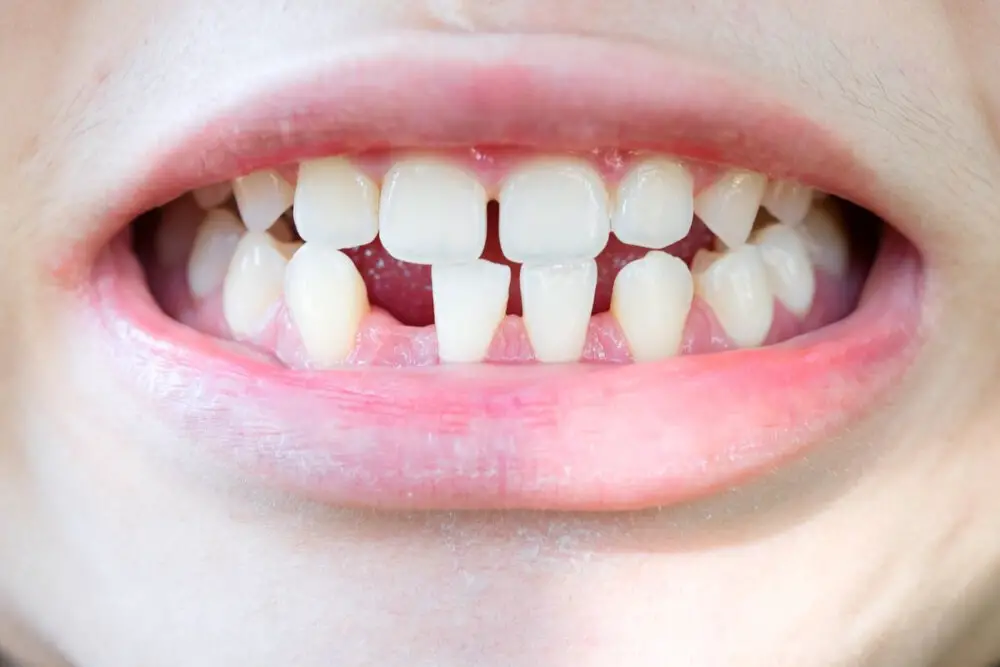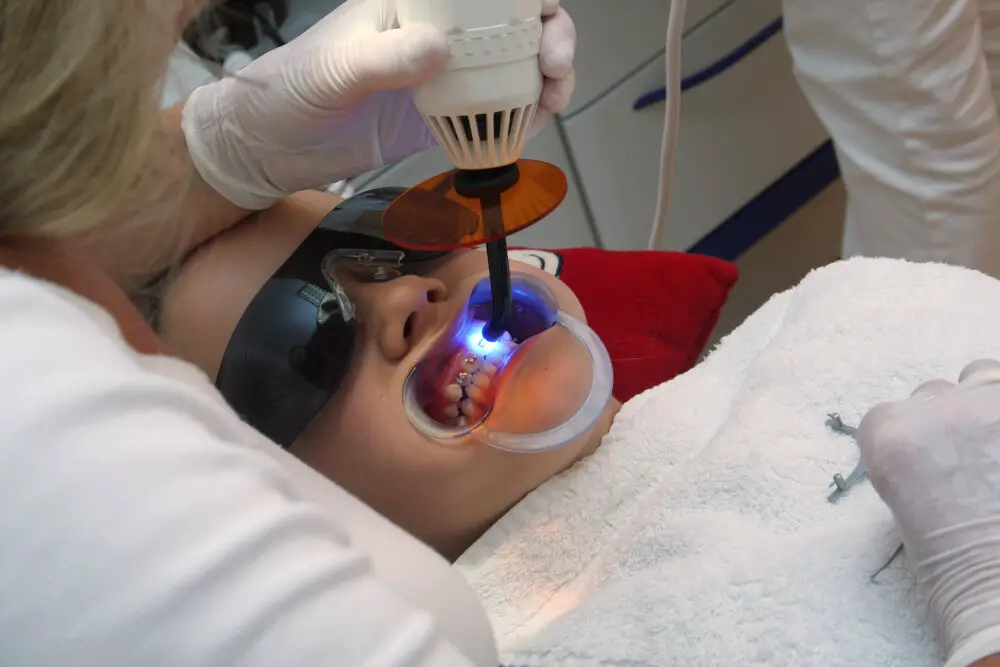Straightening Teeth: How Long Does it Take to Achieve a Perfect Smile?

Straightening teeth has become a popular trend among people who want to improve their appearance and boost their self-confidence. A perfect smile with straight and aligned teeth is often considered a crucial factor in creating a positive first impression, both socially and professionally. The process of straightening teeth involves various treatment options, such as braces, clear aligners, and retainers. However, many people wonder how long it takes to achieve a perfect smile and what factors affect the duration of the treatment. The answer to this question is not straightforward, as several factors can influence the timeline of the teeth straightening process. The severity of the misalignment, the type of treatment chosen, and the patient’s commitment to the treatment plan are some of the factors that can impact the duration of the treatment. Additionally, every person’s orthodontic needs are unique, and thus, the time required to achieve a perfect smile can vary. In this article, we will explore the different treatment options available for teeth straightening and provide an overview of the timeline and factors that contribute to achieving a perfect smile.
Straightening teeth is not only a cosmetic procedure but also essential for maintaining good oral health. Misaligned teeth can cause gum diseases, tooth decay, and even lead to tooth loss. A straighter smile also means easier cleaning, leading to better oral hygiene. Moreover, having a beautiful smile can significantly boost one’s self-esteem and confidence. Straight teeth can make a person feel more attractive, leading to improved social and professional opportunities. It is crucial to consult an orthodontist to determine the best teeth-straightening option, including traditional braces, clear aligners, or lingual braces, to achieve a perfect smile and reap the benefits of improved oral health.
Types of Teeth Straightening Methods

When it comes to teeth straightening, there are several methods to choose from, depending on the severity of the malocclusion and the individual’s personal preference. Traditional braces are still the most popular and effective option, especially for complex cases. They consist of metal brackets and wires that are attached to the teeth and adjusted periodically to gradually align them. Although they may be uncomfortable at first and require some lifestyle adjustments, such as avoiding hard or sticky foods and practicing good oral hygiene, braces can produce remarkable results in as little as 18 months. For those who want a more discreet alternative to traditional braces, clear aligners like Invisalign may be a better choice. Made of transparent plastic, they are custom-fit to the patient’s teeth and can be removed for eating, brushing, and flossing. Invisalign aligners are replaced every few weeks to ensure a gradual and gentle shift of the teeth. While they may take longer to achieve the desired outcome and require more discipline to wear them consistently, clear aligners offer the advantage of being virtually invisible and less restrictive than braces. They are also less likely to cause discomfort or irritation to the gums and cheeks.
There are various methods available for straightening teeth, each with its own advantages and disadvantages. Braces are the most common and traditional method which involves metal brackets and wires to align teeth. Clear aligners are another popular option that uses clear plastic trays to gradually straighten teeth. They are removable and offer more flexibility compared to braces. Retainers are used after braces or clear aligner treatment to maintain the position of teeth. They are usually made of clear plastic or wire and are worn at night. The choice of method often depends on the severity of the dental problem, the patient’s lifestyle and preferences, and the recommendations of the orthodontist. Regardless of the method chosen, achieving a perfect smile can take anywhere from several months to several years depending on the individual case.
There are various methods for straightening teeth, each with their own sets of pros and cons. Traditional braces, for example, are reliable and effective in correcting severe misalignments, but they can be uncomfortable and aesthetically unappealing. Clear aligners, on the other hand, offer a more discreet option but may not be suitable for complex cases and require diligent maintenance. Lingual braces are a great alternative for those who want to keep their treatment hidden, but they can be more difficult to clean and may cause speech impediments. Finally, accelerated orthodontics, which involves using technology to speed up the treatment process, may be faster but can also be more expensive and may compromise the quality of the results. Ultimately, it’s important to weigh the advantages and disadvantages of each method and consult with an orthodontist to determine the best option for your specific needs.
When considering straightening teeth, cost comparison is an important factor to consider. Traditional metal braces tend to be more cost-effective than newer, more advanced options such as clear aligners. It’s important to keep in mind, however, that the length of treatment can also impact overall cost. While metal braces may be cheaper upfront, they often require longer treatment times, which can result in additional costs for adjustments and maintenance. On the other hand, clear aligners may be more expensive initially but can often achieve results in a shorter amount of time, ultimately saving money in the long run. Ultimately, it’s important to weigh the pros and cons of each option and consider your personal budget and needs.
Factors Affecting How Long it Takes to Straighten Teeth

When it comes to straightening teeth, there are several factors that can affect how long the process takes. The severity of the misalignment is one of the most critical considerations. Mild cases of crooked teeth can be corrected in as little as six months, while more severe cases may take up to two years or more. In general, the longer it takes to straighten the teeth, the more complex the treatment plan will be. This can involve a combination of different orthodontic appliances, such as braces, clear aligners, or retainers, and may require more frequent adjustments to ensure the teeth are moving properly. Another factor that can affect how long it takes to straighten teeth is the patient’s age. In general, teeth are easier to move when the patient is younger, as the jawbone is still developing and more pliable. This means that orthodontic treatment may be faster and more effective for children and teenagers than for adults. However, that doesn’t mean that adults can’t achieve straighter teeth; it just may take a bit longer. Additionally, other factors such as the patient’s oral health, their commitment to wearing orthodontic appliances as directed, and their overall dental history can also impact the timeline for achieving a perfect smile.
Misalignment of teeth is a common dental issue that can affect an individual’s overall oral health and appearance. The severity of misalignment can range from mild to severe, with the latter causing significant functional and aesthetic problems. In severe cases, misaligned teeth can lead to difficulty in chewing, speech impediments, and even jaw pain. Additionally, misaligned teeth can also impact one’s self-esteem and confidence, often causing individuals to avoid social situations or smiling in public. Therefore, it is crucial to seek professional dental treatment to correct any misalignment issues and achieve a perfect smile.
Age of the patient is a crucial factor in determining the duration of orthodontic treatment. Children and adolescents often respond more rapidly to treatment due to their still growing jawbones and teeth, which are easier to manipulate. The recommended age for orthodontic treatment is between 10 to 14 years old. However, adults can still benefit from orthodontic treatment, but it may take longer as their teeth and jawbones have stopped growing and are more rigid. Additionally, adult patients may require more complex treatment due to previous dental work, such as crowns or bridges, which can complicate orthodontic treatment. Therefore, the age of the patient must be taken into consideration when planning orthodontic treatment to ensure the best possible results.
Consistency is key when it comes to wearing orthodontic devices. The success of teeth straightening treatment heavily depends on the patient’s commitment to wearing their braces or aligners as directed by their orthodontist. Without consistent use, the teeth may not shift as planned, and the treatment may take longer than expected. Patients should be prepared to wear their devices for the recommended amount of time each day, and to follow any specific care instructions provided by their orthodontist. By staying consistent, patients can achieve a perfect smile and enjoy the long-lasting benefits of properly aligned teeth.
Maintaining good oral hygiene habits is essential in achieving a perfect smile while straightening teeth. Brushing twice a day, using fluoride toothpaste, and flossing regularly will help prevent plaque buildup, tooth decay, and gum disease. It’s also important to avoid sugary and acidic foods and drinks that can erode tooth enamel and cause discoloration. Additionally, visiting a dentist every six months for a cleaning and checkup can help catch any problems early on and ensure that teeth are healthy and properly aligned. By implementing these habits, individuals can support the effectiveness of orthodontic treatment and achieve a beautiful, healthy smile.
Average Treatment Duration for Different Types of Teeth Straightening

When it comes to teeth straightening, the average treatment duration varies depending on the type of treatment used. Traditional metal braces are the most common type of orthodontic treatment, and the length of treatment can range from 18 months to 3 years. This is because the wires and brackets used in traditional braces are adjusted over time to gradually shift teeth into their desired positions. However, newer technologies such as clear aligners like Invisalign, can offer a shorter treatment duration of 6 to 18 months. This is due to the use of custom-made clear aligners that are replaced every few weeks to gradually shift teeth into their desired position. Another factor that can affect the duration of teeth straightening treatment is the severity of the misalignment. Mild to moderate cases of misalignment may only require a shorter treatment duration, while more severe cases may require longer treatment times. Additionally, age can also play a role in the length of treatment as children and teenagers may see faster results than adults due to the flexibility of their bones. Overall, it’s important to consult with an orthodontist to determine the best treatment plan for your specific needs and to discuss the expected treatment duration.
Braces are a popular orthodontic treatment used to straighten teeth and correct bite issues. On average, the treatment duration for braces is between 18 to 24 months, although this can vary depending on several factors. Age, the severity of the dental problem, the type of braces used, and the patient’s compliance with the treatment plan are all factors that can affect the duration of treatment. Younger patients may require longer treatment times as their bones are still growing, while more severe cases may require additional dental procedures to achieve optimal results. The type of braces used can also affect the treatment duration, with traditional metal braces typically requiring longer treatment times compared to newer options like clear aligners. Ultimately, the success of the treatment depends on the patient’s commitment to following the orthodontist’s instructions and attending regular appointments to ensure the best possible outcome.
Clear aligners are a popular and convenient option for orthodontic treatment, but the duration of the treatment can vary depending on several factors. On average, treatment with clear aligners takes between 6 and 18 months, depending on the severity of the misalignment and the patient’s compliance with wearing the aligners as directed. Factors that can affect the duration of treatment include the complexity of the case, the age of the patient, and the consistency with which the aligners are worn. Patients who consistently wear their aligners as directed and keep up with regular check-ups with their orthodontist are more likely to achieve their desired results in a timely manner.
Retainers are an essential part of orthodontic treatment, and their use helps maintain the alignment of teeth after braces are removed. The average duration of retainer treatment varies between patients, usually lasting between six months to a year. However, several factors can influence the duration of treatment, such as the severity of the initial misalignment, the type of treatment used, and the patient’s compliance with wearing the retainer as instructed. In some cases, retainers may be used for a longer period to prevent teeth from shifting back to their original position. Nonetheless, patients can expect that the use of retainers will ensure their teeth remain straight and aligned, providing a perfect smile for years to come.
Tips for Achieving a Perfect Smile Faster

Achieving a perfect smile is a goal many people strive for. However, it can take time and effort to achieve the desired results. There are several tips to help speed up the process and achieve a perfect smile faster. One of the most important tips is to maintain good oral hygiene. Brushing and flossing regularly can help keep teeth clean and healthy, which can aid in straightening teeth and achieving a perfect smile. In addition, visiting the dentist regularly for cleanings and checkups can help catch any issues early on and prevent them from worsening. Another tip for achieving a perfect smile faster is to consider orthodontic treatments such as braces or clear aligners. These treatments can help straighten teeth and correct any alignment issues, which can lead to a more perfect smile. It is important to consult with an orthodontist to determine the best treatment option for your specific needs. Additionally, following the orthodontist’s instructions and wearing the braces or aligners as directed can help speed up the process and achieve the desired results faster. With a combination of good oral hygiene and orthodontic treatments, achieving a perfect smile can be within reach.
Following an orthodontist’s instructions is crucial when it comes to the process of straightening teeth. It can take months or even years to achieve a perfect smile, and it requires patience, commitment, and diligence to see the desired results. Orthodontic treatment involves wearing braces, aligners, or other dental appliances, and it also involves regular visits to the orthodontist’s office to make adjustments and monitor progress. Patients must maintain good oral hygiene, avoid certain foods that can damage the braces or aligners, and wear rubber bands or headgear as prescribed. It’s essential to follow the orthodontist’s instructions and attend all appointments to ensure the treatment plan stays on track and the final results are achieved.
Maintaining good oral hygiene is crucial in achieving a perfect smile when straightening teeth. Brushing twice a day with fluoride toothpaste and flossing daily is essential to remove food particles and plaque that can cause tooth decay and gum disease. Using an antiseptic mouthwash can also help eliminate bacteria and freshen breath. It is also important to limit sugary and acidic foods and drinks that can erode tooth enamel and cause discoloration. Regular dental check-ups and cleanings can detect and prevent dental problems, and orthodontic treatment can correct misaligned teeth and bite issues. By following these oral hygiene practices, individuals can achieve a healthy and beautiful smile.
When undergoing orthodontic treatment, it is crucial to avoid hard and sticky foods to prevent damaging the braces or wires. Hard foods such as nuts, hard candy, and popcorn can dislodge or break the brackets or wires, prolonging the treatment time. Meanwhile, sticky foods like caramel, taffy, and chewing gum can get stuck in the braces, making it difficult to clean and increasing the risk of tooth decay. It is best to opt for softer, easy-to-chew foods like cooked vegetables, soft fruits, and lean protein to ensure that the orthodontic treatment progresses smoothly without any interruptions. Following a balanced diet and avoiding harmful habits like nail-biting or pencil-chewing can help achieve a perfect smile in a shorter time frame.
One of the most important factors in achieving a perfect smile through teeth straightening treatment is not skipping appointments. Orthodontic treatment requires consistent monitoring and adjustments to ensure that the teeth are moving in the desired direction. Missing appointments can cause delays in treatment and may even reverse progress that has been made. It’s crucial to prioritize attending all scheduled appointments to ensure that the treatment plan stays on track and the desired results are achieved as quickly and effectively as possible. Additionally, attending appointments allows for any issues or concerns to be addressed promptly, ensuring a smooth and successful treatment process.
Teeth straightening is an essential dental treatment that involves aligning crooked teeth to improve their appearance and functionality. Straightening teeth can help correct various dental issues, such as overcrowding, gaps, misaligned bites, and improve oral hygiene. The duration of treatment varies as it depends on various factors such as the severity of the case, age, the type of braces used, and the patient’s commitment to follow the orthodontist’s instructions. Patients who wear braces regularly, attend all scheduled appointments, and maintain good oral hygiene achieve faster results. In contrast, patients who neglect their braces’ care, miss appointments, and engage in bad oral habits may experience longer treatment times. Therefore, patients need to follow their orthodontist’s instructions, wear their braces diligently, and maintain proper oral hygiene to achieve the perfect smile they desire.
Following an orthodontist’s instructions is crucial for achieving a perfect smile in the shortest possible time. Patients must make a conscious effort to adhere to their orthodontist’s recommendations, such as wearing their braces or aligners for the recommended duration each day, avoiding certain foods that can damage their appliances, and keeping their teeth and appliances clean. Patients should also attend all scheduled appointments promptly, as missing appointments can delay treatment progress. Consistency and patience are key to ensuring an effective and timely orthodontic treatment. By following their orthodontist’s instructions, patients can achieve a beautiful and healthy smile that they can be proud of for a lifetime.
It’s essential to remind ourselves that achieving a perfect smile is a journey, not a race. The process of straightening teeth takes time and patience, and it’s crucial to trust the process. While some people may see results sooner than others, it’s important to remember that everyone’s teeth are unique and require different levels of treatment. It’s also essential to follow the orthodontist’s instructions and maintain good oral hygiene to ensure that the treatment is effective. So, don’t get discouraged if it takes longer than expected to achieve your perfect smile. Remember that the end result will be worth the wait, and a beautiful, healthy smile is an investment that will last a lifetime.
Conclusion

In conclusion, achieving a perfect smile through teeth straightening can take anywhere from several months to a few years depending on the severity of dental issues. The duration of the treatment may also depend on the chosen method, such as traditional braces, clear aligners, or lingual braces. Regardless of the method, it is essential to follow the orthodontist’s instructions to ensure that the treatment progresses as planned. It’s important to remember that the results are worth the wait, and a perfect smile not only enhances one’s appearance but also boosts one’s confidence and self-esteem.







